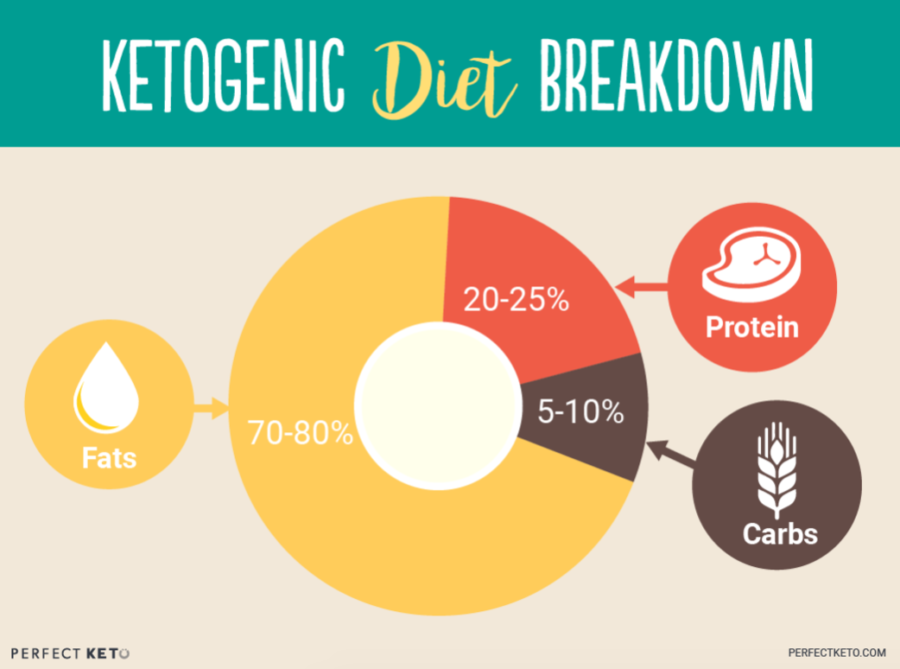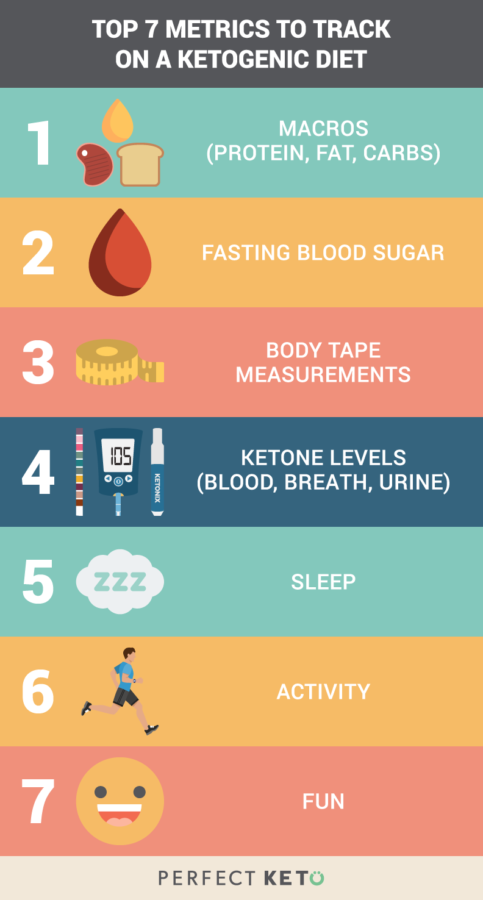It can be overwhelming to know where to start on a ketogenic diet. The best way to start is to take a few minutes, put down our phones, and ask ourselves: what is our most important goal? From there, we can read-up on relevant keto information, prepare our grocery list, and go for it!
The goal usually involves something measurable, which means it’s important for us to pick the metrics that our meaningful to us, and track them. Not doing so would be like shooting a basketball and not looking to see if it went in the hoop. Tracking metrics can be a bit intimidating, but it perhaps the most motivating and rewarding thing you can do on your journey. Progress = happiness.
Dave Korsunsky is the founder of Heads Up Health, a health tracking platform that connects all our health data and makes it easy for us to see the metrics we care about, in a single view. The goal of Heads Up Health is to help us reach our goals! Dave is a close friend of Perfect Keto and graciously took the time to share the top 7 basic metrics he recommends tracking on a ketogenic diet and reminds us to have fun with it. 🙂
Top 7 Basic Metrics to Track on a Low-Carb, Ketogenic Diet
By Dave Korsunsky
#1 Macros (Grams of Protein, Fat, Carbs)
Learning how to correctly calculate and track macros is a core foundation of a properly designed keto diet. We list some recommended macro calculators in the appendix to get you started.
Using an app like MyFitnessPal for a few weeks is a great way to ensure you are staying on target with your calculated macros. Do you need to track everything you eat in an app for the rest of your keto existence? No. But you do need to track for a few weeks so you can be honest with yourself about whether or not you are managing your food intake in support of your goals.
Tracking with a nutrition app like MFP can also help you identify foods you thought were “safe” but may actually be sabotaging your progress with hidden carbs and sugars.
Additionally, if you hit stalls or your goals change on keto, you may need to revisit and adjust your macros and track for a couple weeks to recalibrate to your food choices.

#2 Fasting Blood Sugar
Take this reading first thing in the morning before consuming any food or drink. This number is an excellent indicator for how well you are managing your macros and exercise on keto. Fasting glucose should trend down as you reduce carbs and deplete your body’s glycogen stores. If the number ticks up on a given day, chances are your carb intake was higher and/or physical activity was lower. As you get more experienced with how your body’s fasting glucose measurements respond to keto, you will find this to be one of the most useful metrics you can collect.
Read Next: Glucose Ketone Index (GKI): What It Is and Quick Calculator
#3 Body Tape Measurements
This is a fun metric because we get to see how far we’ve come on the keto journey. Personally, I wish I had tracked my measurements before starting keto and I am sure there are many others who feel the same.
Truth is, compared to scale weight, body tape measurements are a way better metric to use for tracking your body composition changes. In many cases, we may see only modest weight loss on the scale as we go keto. Some of us may even gain weight as we shed fat and replace it with lean muscle. In these cases, the scale can be misleading but the tape measure won’t lie.
Looking back at your measurements over the course of months or even years can be incredibly motivating to see just how far you’ve come. Common sites to measure include thighs, hips, waist, chest, bicep, and neck. <!–See this post for more information on tracking body tape measurements.–>
#4 Ketone Levels (Blood, Breath, or Urine)
On a well-formulated keto diet, your body should be entering into a state of ketosis naturally. Testing for the presence of ketones can help confirm this is the case and can be a very helpful piece of biofeedback as you fine tune the keto diet for your own body. Check out Perfect Keto’s Urine Test Strips.
Some people find they can enter ketosis effortlessly after just a few days of low-carb eating. For others, it could take weeks of trial and error. Variance across individuals can be attributed to genetics, personal levels of insulin sensitivity/resistance and other factors that are unique to each of us. That’s why testing can be a helpful part of the process.
Many people tend to start with urine sticks as these are affordable and easy to use. Using a blood ketone meter is considered to be the most consistent and accurate method, but the meter and the test strips can be costly. Lastly, devices from Ketonix and LEVL can provide a reusable breath test that can provide a nice compromise.
Seeing ketones register on the meter can be fun and motivating for some people. For others, it can be frustrating if you feel like you are doing everything right but not seeing results on the meter. “Don’t chase the ketones” is a phrase you may hear in the ketosphere. Simply put, don’t get too hung up on these numbers. Use them as a guide but don’t obsess over them. Ketosis is a natural byproduct of a proper keto lifestyle so just stick to the fundamentals and results will follow.
#5 Sleep
What does sleep have to do with weight loss, metabolism, and keto? A lot, actually. Sleep can be just as important as proper nutrition when it comes to managing blood glucose levels, especially for those already dealing with metabolic diseases.
Poor sleep quality can affect the hormones that regulate appetite and cause us to crave nutrient-poor, high calorie foods [x]. Lack of sleep can also create symptoms in the body that resemble insulin resistance.
Fortunately, it’s easy to track sleep these days. Just put a device on your wrist and it will automatically track sleep. If your wearable can also track heart rate, the data will be even more accurate. There are some free apps like SleepCycle that can also help you start collecting some baseline sleep data.
Optimal sleep quantity will vary depending on the individual with 6-8 hours being a good range to shoot for. A good sleep tracker will also provide some data around sleep quality. If you see a high number of wake events during the night and/or low amounts of deep and REM sleep, it may worth talking to your doctor about a diagnostic sleep study to rule out sleep apnea. Lastly, sleep timing is important. Aligning your sleep schedule to the natural light/dark cycle can be very beneficial.
# 6 Activity
When are sitting (at work, at home in front of the TV) our bodies are in a metabolically dysfunctional state. Electrical activity in the leg muscles shuts off and calorie burn drops to less than one calorie per minute. In fact, in our modern society, we now spend more time sitting than we do sleeping! It’s one of the reasons why many health experts now call “sitting” the new “smoking” due to the health risks associated with sedentary behavior (i.e. sitting on your butt all day).
The best keto diet in the world will have limited benefits if you aren’t getting off your butt and getting enough movement. Our bodies have evolved to move! Getting a minimum of 10,000 – 15,000 steps per day can be an incredibly easy and effective way to ensure we are avoiding sedentary behavior and getting enough movement to maintain a healthy metabolism.
#7 Fun
Wait, what? How the heck do you track fun? Simple answer – you don’t. Here we just want to remind everyone not to forget to enjoy the journey. Spend time with friends and family, laugh, love, spend time outdoors, get plenty of natural sunlight and enjoy the occasional indulgence in life. After all, we only get one go around on this planet so enjoy the ride. Good keto health with a positive and well-balanced life outlook are a winning combination!
Top 7 Metrics to Track on a Ketogenic Diet

The most important action we can take is to define our goal and then craft a healthful, nutritious diet that will help us reach it. All that’s left after that is to follow the path and track our results. Seeing the personal progress is something you must not miss. Perfect Keto’s recommendation is to use Heads Up Health and have a blast with it. We strongly encourage everyone to read more on the Heads Up Health blog or better yet, sign up for a completely free trial.
Check back soon for another post from Dave Korsunsky about the advanced metrics that are best to track on a ketogenic diet, for all the biohackers out there! The next post will cover,
- Lab testing (lipids, inflammation, thyroid, metabolic markers and more…)
- Glucose:ketone index
- Insulin load
- Fasting intervals
- Heart rate variability
- Bristol stool chart
You can catch more from Dave speaking at KetoCon 2017 or on his recent episode on the 2 Keto Dudes podcast.
[x] https://www.ncbi.nlm.nih.gov/pubmed/15531540